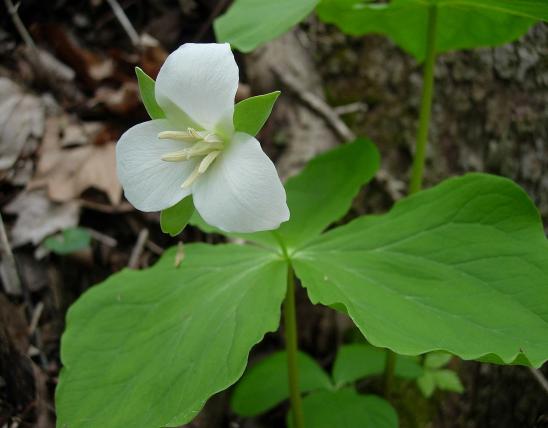
The Ozark wake robin is a woodland trillium. Its flowers consist of 3 white to pink petals above 3 green sepals. The slender, solitary stems are dark green with a purplish tinge near the ground. They grow from a thickened rhizome. Its 3 leaves grow around the stem in a circle. Leaves are dull or grass green, ⅜ to 1 inch wide and 1⅝ to 3⅜ inches long. They are blunt or rounded at the tips. A single flower blooms at the end of a short stalk above the circle of leaves. Blooms April to May.
Similar species: Ozark wake robin can be distinguished from other trilliums by its narrower leaves. The sepals, which are modified leaves immediately beneath the petals, have 5 instead of 3 prominent veins. The Ozark wake robin is the only trillium in southwest Missouri with a stem between the leaves and the flower. All other species have the flowers attached immediately above the leaves.
Height: 7 to 10 inches.

It is a rare and local species with most populations concentrated in the Cassville area of Barry County.
Habitat and Conservation
Upland hardwood forests of the southern Ozarks of Missouri. It occurs in cherty, acidic soils of oak-hickory forests, usually growing on slopes. Conservation efforts include habitat improvement, excluding cattle during the growing season, and monitoring. One population is protected on public land. Ozark wake robin is a unique variety of a species known principally from the Atlantic Coastal Plain.
Status
A Species of Conservation Concern, this plant is imperiled within our state and is vulnerable globally.
Human Connections
This rare wildflower was discovered by amateur naturalist Cora Shoop, who showed a specimen to botanist Julian Steyermark. He accompanied her to the site to study the plant. After this foray, they eventually married. Julian Steyermark became Missouri’s most famous botanist.
Ecosystem Connections
Trilliums use their leaves to produce and store energy in their rhizomes, so that they have strength to bloom again the next spring. Because trilliums only have 3 leaves, which are so close to the flowers, picking trillium flowers removes the plant’s ability to feed itself.

























